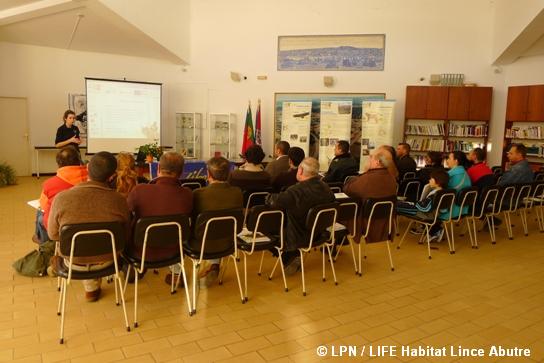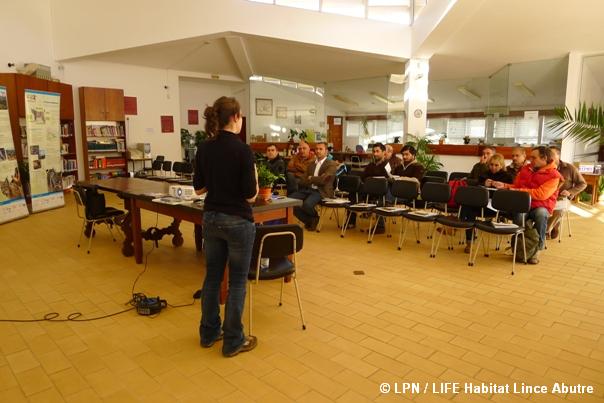Population of Silves gets to know LIFE Habitat Lince Abutre
On April 5, São Bartolomeu de Messines, at Silves (Algarve), was the stage of a three hour talk about the LIFE project Habitat Lince Abutre, the Iberian lynx and several other nature conservation themes. At the room were people from the hills and the Algarvian barrocal, local hunting associations, SEPNA (environmental police), officials of the town council, students and representatives of the National Captive Breeding Center of the Iberian Lynx (CNRLI), totaling 22 people.
After presenting the project, it was time to clarify the doubts brought by the audience. Given the proximity to the CNRLI, also located at Silves, it was predictable that questions about the reintroduction of the Iberian lynx would eventually arise. And so it was! We explained the set of measures implemented on behalf of the species conservation at the Iberian level, distinguishing the actions practiced in-situ, in which this project is included, and ex-situ, through the network of captive breeding centers, showing how they complement each other aiming the conservation of a critically endangered species.
The illegal use of poison was another important topic discussed at this meeting. People denounced cases and were advised how to proceed in case of detection or suspicion of a case of poisoning.
Another issue that got people’s attention and concern, especially of hunters, was the incidence of bovine tuberculosis in wild boar and the risks to human health due to the handling and consumption of animals potentially infected by the disease. The theme arose after explaining one of the project’s actions that aims to assess the sanitary status of domestic and wild fauna that share pathologies and potential habitat with the Iberian lynx, being one of those pathologies the bovine tuberculosis, a disease with a strong incidence on large game, namely deer and wild boar (the latter an important game species in the Caldeirão Hills). Therefore, good practice measures were made known to those present, concerning the handling of wild boars killed and advices for an efficient detection of infected animals.
Throughout the evening we also talked about some behavioral characteristics of the Iberian lynx and its important role in the ecosystem’s balance, while top predator, naturally controlling the densities of more common and opportunistic predators.
The severe decline of wild rabbits is already a mandatory theme in these meetings… We discussed the incidence of a new strain of the viral hemorrhagic fever in Portugal, the (in)effectiveness of vaccination and shared experiences about the success of the measures applied (by the project and local hunting associations) to increase the local densities of this important prey species.


The barrier of reduced information sharing between the various sectors related to the Mediterranean landscape (forestry, livestock husbandry, hunting, nature conservation, ecotourism, apiculture, etc.) is slowly being overcome. These gatherings, promoted all over the project’s intervention area, are an important contribute to this aim – during this meeting a local hunter stressed the importance of sharing with locals the information collected and lessons learned with the project, so that everyone could benefit from the project’s experience and results.
The team of Habitat Lince Abutre LIFE project takes this opportunity to thank the civil parish of São Bartolomeu de Messines, especially its president, João Correia, and Maria João Barata, for providing us a space for this meeting and for all their support in its disclosure among the local population.
We also thank Rodrigo Serra, director of the CNRLI, and Alexandre Azevedo for their presence and contribute given to this session.